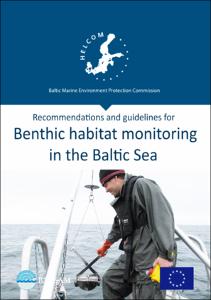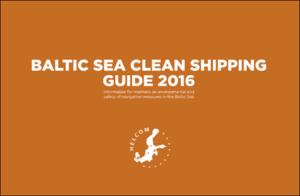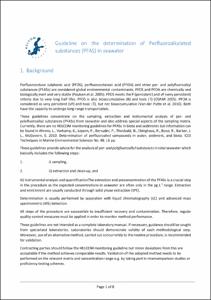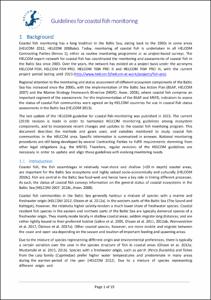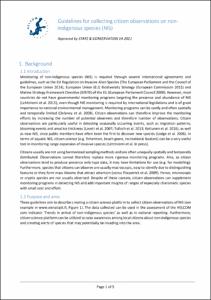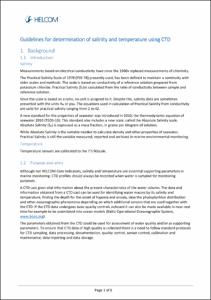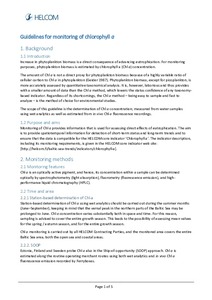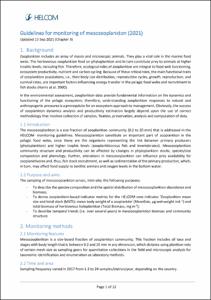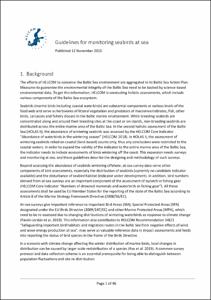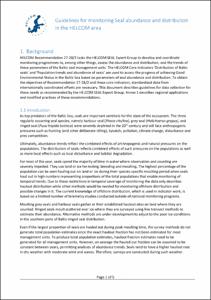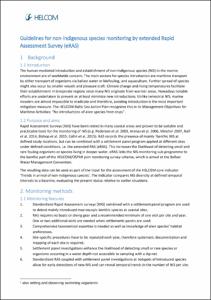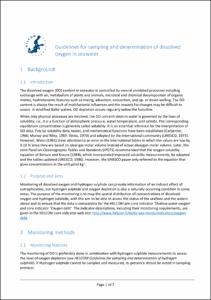Browsing ⇒ HELCOM: Baltic Marine Environment Protection Commission by Title
Now showing items 1-20 of 49
-
BALSAM Project 2013‐2015: Recommendations and Guidelines for Benthic Habitat Monitoring with Method Descriptions for Two Methods for Monitoring of Biotope and Habitat Extent.
(HELCOM, Helsinki, Finland, 2015)Work package 6 of the BALSAM Project dealt with Baltic benthic habitat monitoring methods and programmes useful for the Marine Strategy Framework Directive (MSFD). This included both as-sessing the usefulness of monitoring ... -
Baltic Sea Clean Shipping Guide 2016 : Information for mariners on environmental and safety of navigation measures in the Baltic Sea.
(HELCOM, Helsinki, Finland, 2016)This information publication aims to give you a general overview of the regional environmental and safety of navigation measures applied in the Baltic Sea to maritime traffic. The focus is on commercial shipping which ... -
Draft guidelines for sampling and determination of total alkalinity.
(HELCOM, Helsinki, Finland, 2017)Although not listed among HELCOM Core Indicators, total alkalinity should be monitored to provide information of alterations in the carbonate buffer system, which may be induced by changing weathering processes on the ... -
Draft guidelines for sampling and determination of total nitrogen.
(HELCOM, Helsinki, Finland, 2017)Total nitrogen includes all organic and inorganic forms of nitrogen, dissolved as well as suspended or particulate. The results are an estimation of the total amount of nitrogen, not only the dissolved bioavailable ... -
Guideline for the determination of heavy metals in sediment.
(HELCOM, Helsinki, Finland, 2018)This Technical note provides advice on the analysis of heavy metals in total marine and coastal sediments and sieved fractions, including sampling and sample handling. The analysis of heavy metals in sediments basically ... -
Guideline on the determination of Perfluoroalkylated substances (PFAS) in seawater.
(HELCOM, Helsinki, Finland, 2018)Perfluorooctane sulphonic acid (PFOS), perfluorooctanoic acid (PFOA) and other per- and polyfluoroalkyl substances (PFASs) are considered global environmental contaminants. PFOS and PFOA are chemically and biologically ... -
Guidelines for coastal fish monitoring.
(HELCOM, Helsinki, Finland, 2019)Coastal fish communities are influenced by a plethora of impacting variables, including human-induced pressures related to overexploitation, climate change, eutrophication, contaminants, habitat degradation, effects of ... -
Guidelines for collecting citizen observations on non-indigenous species (NIS).
(HELCOM, Helsinki, Finland, 2021)Monitoring of non-indigenous species (NIS) is required through several international agreements and guidelines, such as the EU Regulation on Invasive Alien Species (The European Parliament and the Council of the European ... -
Guidelines for determination of salinity and temperature using CTD.
(HELCOM, Helsinki, Finland, 2017)Salinity Measurements based on electrical conductivity have since the 1960s replaced measurements of chlorinity. The Practical Salinity Scale of 1978 (PSS-78) presently used, has been defined to maintain a continuity ... -
Guidelines for monitoring of chlorophyll a.
(HELCOM, Helsinki, Finland, 2016)Increase in phytoplankton biomass is a direct consequence of advancing eutrophication. For monitoring purposes, phytoplankton biomass is estimated by chlorophyll a (Chl a) concentration. The amount of Chl a is not a ... -
Guidelines for monitoring of mesozooplankton.
(HELCOM, Helsinki, Finland, 2021)The mesozooplankton is a size fraction of zooplankton community (0.2 to 20 mm) that is addressed in the HELCOM- monitoring guidelines. Mesozooplankton constitute an important part of zooplankton in the pelagic food webs, ... -
Guidelines for monitoring of phytoplankton species composition, abundance and biomass.
(HELCOM, Helsinki, Finland, 2023)Phytoplankton primary producers constitute the basis of the pelagic food web and phytoplankton community composition directly affects the nutrition, growth, reproduction and survival of different organisms (see Hällfors ... -
Guidelines for monitoring of radioactive substances.
(HELCOM, Helsinki, Finland, 2020)Routine station network for regular monitoring programme is recommended as indicated in the following list and maps. Sampling frequency is once a year. Additional stations and samples are recommended, and reporting of the ... -
Guidelines for monitoring of turbidity.
(HELCOM, Helsinki, Finland, 2017)Turbidity estimates the impact of light scattering due to particles on the level of light attenuation in the water column. It is affected by total suspended solids (i.e., organic and inorganic particles) in the water, and ... -
Guidelines for monitoring of water transparency (Secchi depth).
(HELCOM, Helsinki, Finland, 2017)Water transparency serves as an index for the trophic state of a water body. It reflects eutrophication through changes in the phytoplankton abundance; increase in the ambient nutrient status in the water leads to higher ... -
Guidelines for monitoring seabirds at sea.
(HELCOM, Helsinki, Finland, 2021)The efforts of HELCOM to conserve the Baltic Sea environment are aggregated in its Baltic Sea Action Plan. Measures to guarantee the environmental integrity of the Baltic Sea need to be backed by science-based environmental ... -
Guidelines for monitoring Seal abundance and distribution in the HELCOM area.
(HELCOM, Helsinki, Finland, 2018)HELCOM Recommendation 27-28/2 tasks the HELCOM SEAL Expert Group to develop and coordinate monitoring programmes to, among other things, assess the abundance and distribution, and the trends ofthese parameters of the Baltic ... -
Guidelines for non-indigenous species monitoring by extended Rapid Assessment Survey (eRAS).
(HELCOM, Helsinki, Finland, 2017)The human-mediated introduction and establishment of non-indigenous species (NIS) in the marine environment are of worldwide concern. The main vectors for species introduction are maritime transport by either transport of ... -
Guidelines for sampling and determination of ammonium.
(HELCOM, Helsinki, Finland, 2017)Dissolved inorganic nitrogen is present in seawater both as nitrite, nitrate and ammonium. As a complement to the overall assessment of nutrient status, detailed information on the distribution of different species must ... -
Guidelines for sampling and determination of dissolved oxygen in seawater.
(HELCOM, Helsinki, Finland, 2018)The dissolved oxygen (DO) content in seawater is controlled by several unrelated processes including exchange with air, metabolism of plants and animals, microbial and chemical decomposition of organic matter, hydrodynamic ...
 Repository of community practices in Ocean Research, Applications and Data/Information Management
Repository of community practices in Ocean Research, Applications and Data/Information Management
